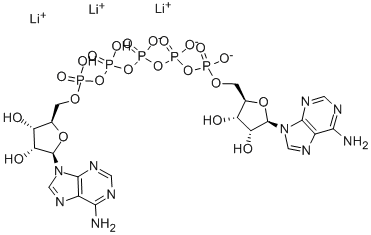A diadenosine polyphosphate stored in secretory granules of thrombocytes, chromaffin and neuronal cells. After release into the extracellular space, it affects a variety of biological activities in a wide range of target tissues. In the nervous system it acts through various purinergic receptors. It also activates 5′-nucleotidase and inhibits adenosine kinase activity in vitro. Ap5A is metabolized by soluble enzymes in the blood plasma and by membrane-bound ectoenzymes of a number of cell types including endothelial and smooth muscle cells. In cardiac muscle, pM to nM concentrations significantly increase the open-probability of ryanodine-receptor (RyR2) gates, with prolonged action due to slow dissociation from the receptor.
